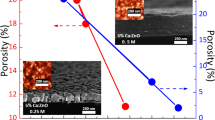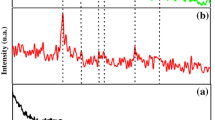Abstract
ZnO, Li doped, and Li, Ni co-doped ZnO powders to be later used as transparent conductive oxide thin film were prepared by heat treatment of gels obtained from alcoholic Zn(CH3COO)2·2H2O, LiNO3·nH2O and NiSO4·6H2O solutions with (CH3CH2OH)3N as chelating agent. The properties of the powders and their thermal treatment were studied by thermogravimetric and differential thermal analysis (TG/DTA), differential scanning calorimetry, evolved gas analysis coupled with mass spectroscopy, Fourier transform infrared spectroscopy, X-ray diffraction and scanning electron microscopy coupled with energy-dispersive X-ray. The as-prepared gels consisted of submicron platelet-like particles and contained zinc acetate dihydrate and hydrozincite in different amount and with different preferred orientations. During annealing of the gels, zinc acetate decomposed between 110 and 350 °C with the release of CH3COOH, acetone and CO2. The N content of the chelating agent was responsible for NH3 and NO evolution. The thermal behavior of the doped gels was similar, but there were also differences in the mass losses, amount of released gases. Based on TG/DTA data, ZnO powders were obtained from the gels by annealing both at 275 and 500 °C. After heating at 275 °C, the obtained powders consisted of spherical 1–2 micron grains of wurtzite. The inclusion of the dopants was successful according to EDX and cell parameter data. Thermal study of the powder annealed at 275 °C confirmed that they still contain some zinc acetate. In the case of the doped samples, the mass loss was smaller, since the Li and Ni dopants catalyzed the composition of zinc acetate during the previous annealing at 275 °C. After annealing the gels at 500 °C, stable undoped ZnO or doped ZnO particles were obtained.















Similar content being viewed by others
References
Lee JY, Lee JH, Kim HS, Lee CH, Ahn HS, Cho HK, Kim YY, Kong B, Lee HS. A study on the origin of emission of the annealed n-ZnO/p-GaN heterostructure LED. Thin Solid Films. 2009;517:5157–60.
Hassan JJ, Mahdi MA, Yusof Y, Abu-Hassan H, Hassan Z, Al-Attar HA, Monkman AP. Fabrication of ZnO nanorod/p-GaN high-brightness UV LED by microwave-assisted chemical bath deposition with Zn(OH)2–PVA nanocomposites as seed layer. Opt Mater. 2013;35:1035–41.
Malek MF, Mamat MH, Khusaimi Z, Sahdan MZ, Musa MZ, Zainun AR, Suriani AB, Md Sin ND, Abd Hamid SB, Rusop M. Sonicated sol–gel preparation of nanoparticulate ZnO thin films with various deposition speeds: the highly preferred c-axis (0 0 2) orientation enhances the final properties. J Alloys Compd. 2014;582:12–21.
Qu X, Wang W, Lv S, Jia D. Thermoelectric properties and electronic structure of Al-doped ZnO. Solid State Commun. 2011;151:332–6.
Janotti A, Van de Walle CG. Fundamentals of zinc oxide as a semiconductor. Rep Prog Phys. 2009;72:126501.
Li L, Shan CX, Li BH, Yao B, Zhang JY, Zhao DX, Zhang ZZ, Shen DZ, Fan XW, Lu YM. The compensation source in nitrogen doped ZnO. J Phys D Appl Phys. 2008;41:245402.
Yao B, Xie YP, Cong CX, Zhao HJ, Sui YR, Yang T, He Q. Mechanism of p-type conductivity for phosphorus-doped ZnO thin film. J Phys D Appl Phys. 2009;42:015407.
Yu D, Hu L, Qiao S, Zhang H, Len SEA, Len LK, Fu Q, Chen X, Sun K. Photoluminescence study of novel phosphorus-doped ZnO nanotetrapods synthesized by chemical vapor deposition. J Phys D Appl Phys. 2009;42:055110.
Díez-Betriu X, Jiménez-Rioboo R, Sánchez- Marcos J, Céspedes E, Espinosa A, de Andrés A. Amorphous-nanocrystalline Al doped ZnO transparent conducting thin films. J Alloys Compd. 2012;536:S445–9.
Zi-qiang X, Hong D, Yan L, Hang C. Al-doping effects on structure, electrical and optical properties of c-axis-orientated ZnO: Al thin films. Mater Sci Semicond Process. 2006;9:132–5.
Casanova JR, Heredia EA, Bojorge CD, Canepa HR, Kellermann G, Craievich AF. Structural characterization of supported nanocrystalline ZnO thin films prepared by dip-coating. Appl Surf Sci. 2011;257:10045–51.
Toader Al, Mihaiu S, Voicescu M, Anastasescu M, Stroescu H, Nicolescu M, Atkinson I, Gartner M, Zaharescu M. Optical investigations of tin and zinc oxides as TCOs films. Proceedings of SPIE. 2012; 8411–84111U:1–6.
Mihaiu S, Toader A, Anastasescu M, Gabor M, Petrisor T Jr, Stoica M, Zaharescu M. Al-doped and undoped zinc oxide films obtained by soft chemistry. Proc Appl Ceram. 2009;3(1–2):79–84.
Zaharescu M, Mihaiu S, Toader A, Atkinson I, Moreno JC, Anastasescu M, Nicolescu M, Duta M, Gartner M, Vojisavljevic K, Malic B, Ivanov VA, Zaretskaya EP. ZnO based transparent conductive oxide films with controlled type of conduction. Thin Solid Films. 2014;571:724–31.
Prasad RL, Kushwaha A, Szilágyi IM, Kótai L. Solid state thermal degradation behaviour of 1-D coordination polymers of Ni(II) and Cu(II) bridged by conjugated ligand. J Therm Anal Calorim. 2013;114:653–64.
Szilágyi IM, Deák A, Várhelyi C Jr, Madarász J, Pokol G, Gömöry Á, Várhelyi C. Structural and thermal study of assymetric α-dioxime complexes of Co(III) with Cl and methyl-pyridines. Polyhedron. 2010;10:2185–9.
Mihaiu S, Atkinson I, Anastasescu M, Toader A, Voicescu M, Zaharescu M. Spectroscopic investigations of the formation of the Zn–Sn–O nanostructured films. Rev Roum Chim. 2012;57:477–90.
Zaharescu M, Mocioiu OC. Infrared spectroscopy. In: Schneller T, Waser R, Kosec M, Payne D, editors. Chemical solution deposition of functional oxide thin films. Wien: Springer; 2013. p. 213–30 (Chapter 9).
Mihaiu S, Gartner M, Voicescu M, Mocioiu OC, Zaharescu M. Characterization of the ZnO thin films obtained by chemical route. Optoelectron Adv Mat. 2009;3:884–90.
Mihaiu SM, Madarasz J, Pokol G, Szilagyi IM, Kaszas T, Mocioiu OC, Atkinson I, Toader A, Munteanu C, Marinescu VE, Zaharescu M. Thermal behavior of ZnO precursor powders obtained from aqueous solutions. Rev Roum Chim. 2013;58:335–45.
Subhan MA, Ahmed T, Uddin N, Azad AK, Begum K. Synthesis, characterization, PL properties, photocatalytic and antibacterial activities of nano multi-metal oxide NiO–CeO2–ZnO. Spectrochim Acta Part A Mol Biomol Spectrosc. 2015;136:824–31.
Awad MA, Ibrahim EMM, Ahmed AM. Synthesis and thermal stability of ZnO nanowires. J Therm Anal Calorim. 2014;117:635–42.
Farbod M, Jafarpoor E. Hydrothermal synthesis of different colors and morphologies of ZnO nanostructures and comparison of their photocatalytic properties. Ceram Int. 2014;40:6605–10.
Ghule AV, Lo B, Tzing SH, Ghule K, Chang H, Ling YC. Simultaneous thermogravimetric analysis and in situ thermo-Raman spectroscopic investigation of thermal decomposition of zinc acetate dihydrate forming zinc oxide nanoparticles. Chem Phys Lett. 2003;381:262–70.
Saravanan R, Thirumal E, Gupta VK, Narayanan V, Stephen A. The photocatalytic activity of ZnO prepared by simple thermal decomposition method at various temperatures. J Mol Liq. 2013;177:394–401.
Duan Y, Li J, Yang X, Hua L, Wanga Z, Liu Y. Cunxin Wang, Kinetic analysis on the non-isothermal dehydration by integral master-plots method and TG–FTIR study of zinc acetate dihydrate. J Anal Appl Pyrolysis. 2008;83:1–6.
Lin CC, Li YY. Synthesis of ZnO nanowires by thermal decomposition of zinc, acetate dihydrate. Mater Chem Phys. 2009;113:334–7.
Mereu RA, Mesaros A, Petrisor T Jr, Gabor M, Popa M, Ciontea L, Petrisor T. Synthesis, characterization and thermal decomposition study of zinc propionate as a precursor for ZnO nano-powders and thin films. J Anal Appl Pyrolysis. 2013;104:653–9.
Caglar M, Caglar Y, Aksoy S, Ilican S. Temperature dependence of the optical band gap and electrical conductivity of sol–gel derived undoped and Li-doped ZnO films. Appl Surf Sci. 2010;256:4966–71.
Yan X, Hu D, Li H, Li L, Chong X, Wang Y. Nanostructure and optical properties of M doped ZnO (M=Ni, Mn) thin films prepared by sol–gel process. Phys B. 2011;406:3956–62.
Acknowledgements
The financial support of EU (ERDF) INFRANANOCHEM-No. 19/01.03.2009 Project is gratefully acknowledged. I.M.S. thanks for a János Bolyai Research Fellowship of the Hungarian Academy of Sciences and an OTKA-PD-109129 Grant. S.B. acknowledges the Postdoctoral Fellowship programme of the Hungarian Academy of Sciences (2013–2015).
Author information
Authors and Affiliations
Corresponding authors
Rights and permissions
About this article
Cite this article
Mihaiu, S., Szilágyi, I.M., Atkinson, I. et al. Thermal study on the synthesis of the doped ZnO to be used in TCO films. J Therm Anal Calorim 124, 71–80 (2016). https://doi.org/10.1007/s10973-015-5147-2
Received:
Accepted:
Published:
Issue Date:
DOI: https://doi.org/10.1007/s10973-015-5147-2




